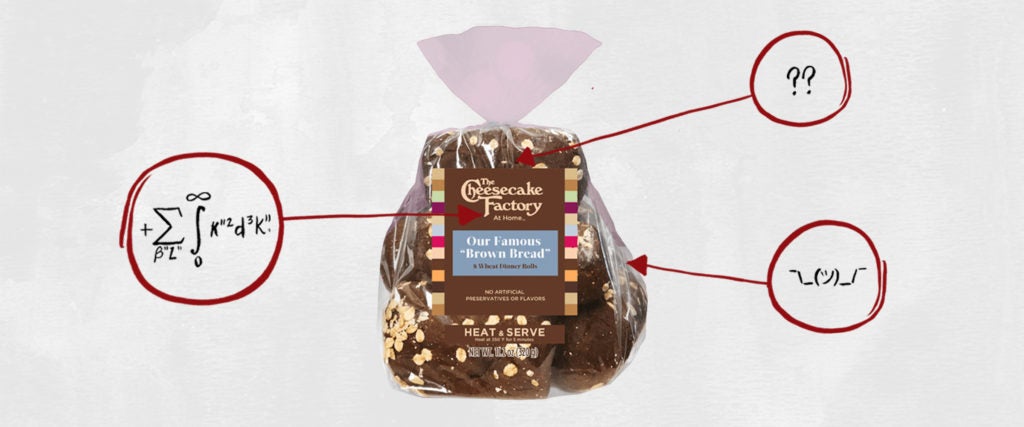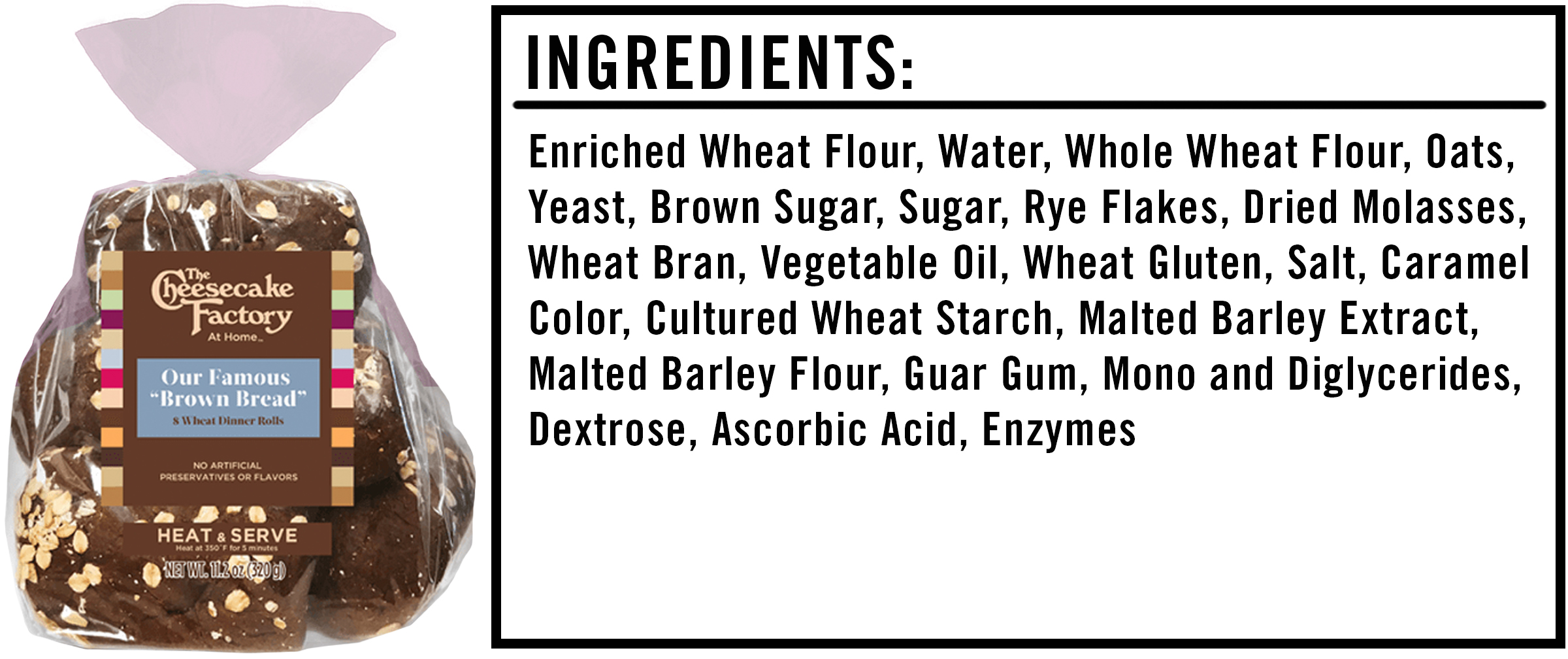We’re often told that you should never eat anything (or put anything on your body) if you don’t recognize everything on the ingredients list. But since most of us have no idea what xanthan gum or potassium benzoate are — or more importantly, what they’re doing to our bodies — we’re decoding the ingredients in the many things Americans put in (and on, or near) themselves.
This edition: Cheesecake Factory “Brown Bread,” which is available in stores and made from 22 separate ingredients that we’ve broken down as they appear on the Kroger website, where we were able to find the full list of ingredients.
What is your favorite complimentary appetizer and why is it the brown bread at The Cheesecake Factory?
— Aaron Gilani (@AaronGilani) December 13, 2020
The Ingredients
1) Enriched Wheat Flour (Wheat Flour, Malted Barley Flour, Niacin, Reduced Iron, Thiamin Mononitrate, Riboflavin, Folic Acid): As we learned in our exploration of the many, many, many ingredients in the McDonald’s Big Mac, enriched flour can end up being far less “enriched” than the name would have you believe. In addition to containing more calories than whole wheat flour, the bleaching process enriched flour often undergoes produces an unfortunate byproduct: A chemical called alloxan, which has been found to induce diabetes in lab-animal test subjects by destroying their pancreas. Whether or not that applies to this enriched flour is hard to say.
- Read Next: What’s the Best Bread You Can Eat?
2) Water: Together, water and flour make dough.
3) Whole Wheat Flour: Like we mentioned while discussing enriched wheat flour, whole wheat flour is good for you, delivering fiber, protein, vitamins and minerals.
4) Oats: Oats are a whole grain, and they’re rich in antioxidants.
5) Yeast: The fungus that makes dough rise.
6) Brown Sugar: Brown sugar is brown because it contains molasses. It has slightly more minerals than white sugar, but should still be limited.
7) Sugar: Each of these rolls contains four grams of sugar, which is a lot for regular ol’ bread. For reference, the American Heart Association recommends men consume no more than 36 grams and women consume no more than 25 grams of added sugar a day.
8) Rye Flakes: Like oats, rye flakes are a whole grain that contains fiber, protein, vitamins and minerals. They add crunchiness to the bread, too.
9) Dried Molasses (Molasses, Wheat Starch): Molasses is made by refining sugarcane and sugar beets, a plant that contains a lot of sucrose, a common sugar. It has more antioxidants than white sugar, but again, should be limited because we all eat too much sugar.
10) Wheat Bran: Wheat bran is the outer layer of the wheat kernel, and it’s primarily a source of fiber.
11) Vegetable Oil (Canola Oil or Soybean Oil): Using vegetable oil in baked goods increases how moist they are when taken out of the oven. While that makes them nicer to eat, according to physician and biochemist Cate Shanahan, consuming too much vegetable oil — which is easy to do, considering Shanahan says roughly 45 percent of the average American’s calories come from refined oils — has serious repercussions (i.e., fatty liver disease, insulin resistance and migraines).
12) Wheat Gluten: Those with celiac disease beware: Wheat gluten is wheat flour that’s been hydrated to activate the gluten, then processed to remove everything but the gluten. It’s added to improve the chewiness of the dough.
13) Salt: To enhance the flavor.
14) Caramel Color: Caramel color is what makes this bread so brown. Unfortunately, as we discovered in our exploration of the ingredients that make up Diet Coke, caramel coloring has an incredibly controversial byproduct called 4-methylimidazole (4-MEI). A 2007 study found that mice fed a diet of 4-MEI developed cancerous lung tumors as a result. The FDA quickly pushed back, noting that a human would have to consume more than 1,000 cans of soft drinks (which are notoriously high in caramel coloring) every day for two years to reach comparable levels of 4-MEI.
Who’s right is still unclear. More recent studies argue that levels of 4-MEI are, in fact, high enough in soda (and possibly other foods) and consumed in sufficient quantities by Americans to increase the risk of developing cancer. Even more recent studies say that caramel coloring is just fine. Do you really have to worry about this in your Cheesecake Factory brown bread? Probably not.
15) Cultured Wheat Starch: This is a fermented wheat product that works as a mold inhibitor and antimicrobial agent. It’s considered to be a cleaner alternative to chemical preservatives.
16) Malted Barley Extract: This is basically a concentrated form of barley, and it can be used to shorten bake times while enhancing the crust color. It also adds a punch of sweetness to the final product, which, in addition to sugar, explains why this brown bread is so damn sweet.
17) Malted Barley Flour: This does almost the same thing as malted barley extract — it assists yeast fermentation, promoting a strong rise, chewy texture and brown crust.
18) Guar Gum: Guar gum is derived from guar beans, and it acts as a stabilizer and thickener. It also helps with the overall chewiness of the bread.
19) Mono and Diglycerides: Mono and diglycerides are typically added to food products as emulsifiers, helping everything mix together well. But as we learned in our exploration of the ingredients in the Dodger Dog, mono and diglycerides are oftentimes packed with trans fats that aren’t listed on the nutrition facts label, which is incredibly problematic. That’s because trans fats are associated with an increased risk of heart disease, stroke and diabetes, and consuming more than you think you are (because they weren’t listed on the label) could do serious damage to your body.
20) Dextrose: Dextrose is a sugar derived from starches, like corn, and it promotes browning in baked goods. Fun fact: Dextrose has a high glycemic index, meaning it quickly raises blood sugar levels, so it’s used in IV solutions to treat low blood sugar and dehydration. People with diabetes might also consume dextrose tablets to raise their blood sugar if they become dangerously low. Because of this blood-sugar-boosting effect, consuming dextrose also provides an almost immediate jolt of energy — followed by an inevitable crash.
21) Ascorbic Acid: Ascorbic acid is just another name for vitamin C, which is used as a preservative.
22) Enzymes: Enzymes help dough rise.
The Takeaway
There are a lot of ingredients in this bread, and some sacrifice healthiness for taste and looks — sugar, mono and diglycerides, caramel color. However, there are also several nutritious ingredients in this bread, like oats, rye flakes and wheat bran, which you’d never find in plain white bread. There are certainly healthier breads out there, but this one isn’t the absolute worst. Just try not to ruin your appetite by eating the whole loaf before dinner is served.


